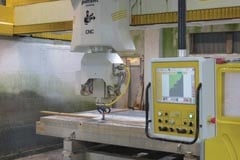A group of customers from southern England and Ireland have been to Gravellona Toce in northern Italy to see the factory where GMM bridge saws are made. They were guests of Roccia Machine in Derby, GMM’s agents for the UK and Ireland.
When GMM was established in northern Italy by Giovanni Lagostina and Luigi Guazzoni on the edge of Alps near the border with Switzerland in 1993 it was in a rented, 70m2 factory that was just big enough to produce one saw at a time.
The factory then, as now, is in the heart of a granite producing area of Italy, surrounded by 200 granite quarries, one marble quarry and a lot of stone processors.
Today, the state-of-the-art factory sits in a couple of acres and the 62 people working there produce 20 bridge saws a month. The company also makes edge and face polishers and employs another 20 people in other factories.
In the 20 years since it was formed, GMM has sold and installed 4,968 bridge saws – or it had last month when a group of stone processors from southern UK and Ireland visited as guests of GMM’s UK and Ireland agents, Roccia Machinery based in Derby. By now it will be a few more.
Corrado Franzi, the Chief Executive Officer of GMM, says GMM has sold more bridge saws than any other manufacturer outside China. He attributes that to the quality of the machines with features such as incredibly stable cast iron bridges.
GMM is currently selling Euro24million-worth of machines a year – a figure that has stayed remarkably constant during the past five years in spite of the World’s financial difficulties.
But if the turnover has stayed the same, the demographics have not. Before the economic crisis hit, GMM sold 45% of its saws in Italy – unsurprisingly as Italy has Europe’s largest stone industry. But maintaining the level of turnover has meant GMM is now selling only 13% of its saws in Italy. The other 87% are exported to 24 countries, including China. Last year it sold 300 of its saws worldwide and the second largest single market was the British Isles, thanks to Roccia, headed by Derrick Fretwell.
Derrick first started selling GMM bridge saws just months after GMM was formed, when the British Isles became only the second region in the world to have an agent for the Italian manufacturer. Derrick, with fellow Roccia Directors Darren Bill and Arran Langford, accompanied their customers on the trip to Italy for last month’s visit.
The group went to see the Litox, in particular (although they also saw other GMM saws in action) at processors working near to the GMM factory before returning to GMM for a closer inspection of a working demonstration unit in the factory. They also saw a range of machines being made, including an Intra that was heading for Cumbria Granite in Carlisle.
The GMM range of CNC saws starts at the Brio and goes through the Intra, Egil, Litox and the Zeda that was introduced at the Marmomacc stone show in Verona last September.
The Litox that was the star performer for the visitors last month is a five axes CNC bridge saw capable of carrying discs up to 1100mm on a head that rotates through 370º and tilts through 90º. It comes with an adjustable galvanized table and brushless motors driving the axes for exceptionally fast, precision cutting. The patent pending vacuum lift is an option for use with blades up to 500mm.
The software on all CNC machines continues to gallop ahead and Christian Guazzoni, GMM’s CAD-CAM supremo, was on hand to explain the latest developments from the four software developers that spend all their time getting more out of the machines.
The GMM guests had seen some of the developments during their visits to the Italian processors. At Maffioli Granite they had seen a demonstration of the software being used to reduce the length of cut to one area at a time, rather than traversing the whole length of the workpiece. It means time is not wasted moving the head backwards and forwards through fresh air.
Like all the software developments, it is about making the job quicker and letting the software decide how it can do that rather than requiring the operator to make those decisions. The easier it is to work the software, the less time needs to be spent programming the machine and the sooner the machine can start working.
For most jobs, the operator has only to enter three parameters: the thickness of the slab, the diameter of the blade and the increment of the cut. The head has to be physically moved to set the start and finish positions, then work can begin. “If the programme is fast, the machine is fast,” said Christian.
There was such a lot of interest in the visit to GMM that Roccia is hosting another visit later in the year for companies from the North of the UK. And anyone who wants to see GMM’s saws in the meantime will be able to visit Roccia’s new showroom shortly, where three of the CNC saws will be available for demonstration alongside a Brembana CNC workcentre that Roccia is now also selling in the UK.

